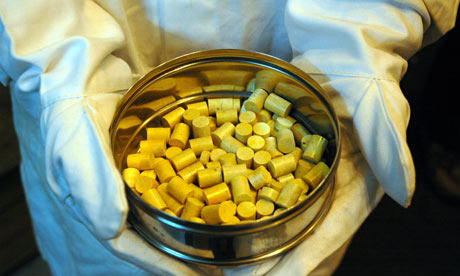What is thorium and how does it generate power?
This Q&A is part of the Guardian's ultimate climate change FAQ

Thorium pellets at the Bhabha Atomic Research Centre (BARC) in Mumbai, India. Photograph: Pallava Bagla/Corbis
Thorium is a radioactive chemical element that could in theory be used to generate large quantities of low-carbon electricity in future decades. Compared to the uranium that powers today's nuclear plants, thorium is more abundant and widely distributed in the Earth's crust. It also offers various safety benefits over uranium: it's not prone to runaway chain reactions that can lead to nuclear disasters; its waste products remains dangerous for a much shorter period; and its byproducts aren't useful for making nuclear weapons. In addition, thorium reactors could theoretically be used to burn up the dangerous plutonium stored in existing nuclear waste stockpiles.
There are various different ways that thorium can – or could – be used to generate energy. A plant being developed in India uses solid thorium fuel in water-cooled reactors similar to those found in today's uranium-based power plants. A completely different approach being explored in Chinaand America is the liquid fluoride thorium reactor (LFTR or "lifter"). This technology was developed to prototype stage by the American government in the 1960s but was then shelved in favour of uranium – possibly because it didn't go hand-in-hand with weapons production. Advocates of this technology argue that its potential is far greater than the water-cooled approach, partly because LFTRs could extract a higher proportion of energy from the thorium fuel.
A third possible approach – promoted by particle physicists such as Nobel prize-winner Carlo Rubbia – would be to use thorium in sub-critical accelerator-driven reactors. However, this remains in the realm of scientific theory rather than nuclear engineering.
After decades of relative obscurity, thorium has been attracting increasing interest in recent years. In 2009, the potential of LFTRs was highlighted in the Guardian's Manchester Report, and September this year saw the launch of the Weinberg Foundation, a new pressure group seeking to accelerate the development of thorium technology. Nonetheless, it's unlikely that thorium will provide a significant proportion of the world's energy before 2030.

No comments:
Post a Comment